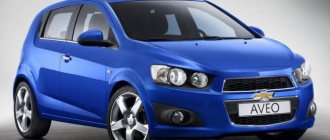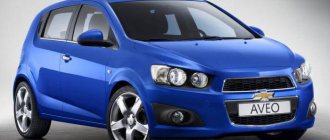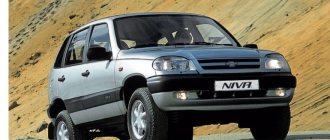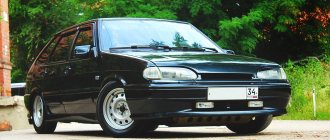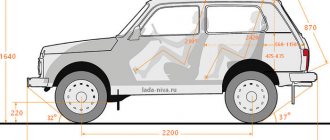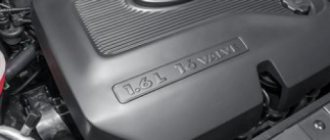VAZ 2115 history
VAZ-2115 “Lada Samara” is a subcompact sedan developed by the Volzhsky Automobile Plant.
Serially produced from 1997 to 2012. The car is part of the Lada Samara family. VAZ-2115 became the first-born of the line codenamed “Samara-2”, after the Sputnik/Samara family, which became the most modified model of this family. This fact of modernization is confirmed by the fact that the VAZ-2115 has significantly changed the rear part of the car body. Namely the trunk lid, lighting devices. No similar transformations followed on the VAZ-2113 and VAZ-2114 cars. VAZ-2115 is a restyled model of VAZ-21099. The new model differs from its predecessor in a new trunk lid, new front and rear optics, bumpers painted in body color, a trunk spoiler with an additional brake light, door sill fairings, door moldings, as well as a new interior and upgraded electrical equipment. Initially, plans to modernize the Samara-2 line included changing not only the exterior of the body and trim, but also improving the suspension, transmission and braking system. However, ultimately, all these nodes were borrowed from the Samara-1 family without any significant changes. This made it possible to achieve a high degree of unification with the “ninth” family. But the implemented improvements in appearance clearly benefited the car. The car received a more streamlined shape, thanks to which the angular outlines of the exterior, characteristic of the first generation Samar, are a thing of the past. Loading things into the trunk has become much more convenient - now the loading height is at the level of the bumper. And a more advanced injection engine develops more power, consumes less fuel and warms up faster. In addition, the electronic engine management system monitors the level of exhaust toxicity.
Electrical equipment has also been improved. Now the car's package includes: electric windows for the front doors, as well as fog lights and heated seats (only on “luxury” modifications). All versions are equipped with an on-board monitoring system that allows you to monitor the proper operation of the lamps, the oil level and the level of coolant and washer fluids, directly from the driver’s seat.
Pilot modifications of the VAZ-2115 (from 1997 to 2000) were equipped with VAZ-21083 carburetor engines with a displacement of 1499 cm³ and a power of 71.6 liters. With. Since 2000, when the car was launched into mass production, they began to install the then new VAZ-2111 engines with distributed fuel injection, a displacement of 1499 cm³ and a power of 77.8 hp. With. And since 2008, the VAZ-2111 engine was replaced by a newer, improved, injection engine VAZ-11183, with a displacement increased to 1596 cm³ and a power of 80.9 liters. With.
Currently, the VAZ-2115 is on wide sale throughout Russia. There are two main configurations: “standard” and “luxury”.
At first, the “related” cars VAZ-21099 and VAZ-2115 were produced at the plant in parallel. Until in 2004, the fifteenth model completely replaced the VAZ-21099.
In 2008, the VAZ-2115 underwent cosmetic changes in its appearance in order to better meet the criteria of modern automotive fashion. So, for example, the old wide molding on the car doors, painted gray from the factory, has given way to new, narrow moldings in body color (popularly called “euro-molding”), which nevertheless do not look very harmonious, given the unchanged design bumpers. And the stripes on the front and rear bumpers began to be painted from the factory in the color of the body, which, according to a minority, visually improved the exterior of the car, but, according to aesthetes, it much worsened and desalinated the entire appearance of the car.
Source
Design
For quite a long time, the interior of cars under the Lada brand did not stand out in any way. But many people liked the appearance. In 2008, a decision was made to make a small change, as modern fashion for the appearance of a car had changed. The designers decided to change the moldings on the doors. If before 2008 they were wide and painted in a standard color on all cars, then after they were narrowed and the color scheme was changed.
Many say that these decisions have improved the appearance of the car, while some argue, on the contrary, that it has only made things worse. There were opinions that the car no longer stood out in the urban crowd.
artifacts, early, pre-production and historical features of the VAZ 2115 that few people know about
Something about the VAZ 2115 that you might not know. Work on model 2115, or more precisely on the restyling of the first generation LADA SAMARA, began in 1993. in Dimitrovgrad. Specialists based on 2109 and 21099 sculpted the new SAMARA 2 body from plasticine right in the wind tunnel.
Thanks to the efforts of designers and engineers, a drag coefficient of 0.429 Cx was achieved versus 0.453 Cx for the 21099 model. Other car models for comparison: Drag coefficient. 1. Lada Priora Cx - 0.32 2. VAZ 2110 Cx - 0.347 3. VAZ 2112 Cx - 0.335 4. VAZ 2111 Cx - 0.381 5. VAZ 21106 Cx - 0.385 6. VAZ 21103M Cx - 0.333 7. Lada Kal ina » Norma » Cx - 0.378 8. Lada Kalina "Lux" Cx - 0.347 9. VAZ 2108 Cx - 0.463 10. VAZ 2109 Cx - 0.463 11. VAZ 2114 Cx - 0.445 12. VAZ 21099 Cx - 0.453 13. VAZ 2115 Cx - 0.429 14 VAZ 2107 Cx - 0.546 15. VAZ 2101 Cx - 0.52 16. VAZ 2121-213, 214 Cx - 0.536 17. VAZ 2123 Shniva Cx - 0.455 18. GAZ 21 Cx - 0.497 19. GAZ 3110 Cx - 0.461 20. nexia - 0.3
Initially, a complete restyling was conceived for all models 08-09-99, with changes to both the front and rear parts of the body:
In 1996 The first pre-production samples were assembled for testing:
Source
The history of the VAZ 2115
The first prototype of the VAZ 2115 from the Lada Samara family, popularly called “Pyatnashka”, was demonstrated in 1997 at the Moscow Motor Show. From the same year, its serial production was launched. The “Fifteen” differed favorably from its predecessor VAZ 21099 from the Lada “Sputnik” family (year of manufacture 1990) in the design of its front end; the fenders, hood and trunk lid received a more rounded shape. The metal bumper was replaced with a plastic one. The look has become more modern thanks to the side decorative overlays. The trunk, the opening of which began from the bumper, became more convenient. The length of the body increased by 22.5 cm. The car became streamlined and successfully passed tests in the wind tunnel.
However, in 1999, designers significantly changed the appearance of the car. New front and rear optics were installed, an additional brake light appeared on the trunk spoiler, and the electrical equipment was improved. The interior has changed for the better.
Since 2007, the car began to be equipped with a 1.6 liter engine. After this improvement, the sedan began to meet European standards.
Compared to its predecessors, this model turned out to be the most expensive, but also the most prestigious. Sales volume amounted to 30% of all VAZ models. On average, 2,600 “Fifteen” cars rolled off the production line every month.
The demand and popularity of the new sedan grew. Therefore, since 2000, its assembly was transferred to the main conveyor belt of the Volzhsky Automobile Plant.
From what year and why was production of the VAZ 2115 discontinued?
In 2012, the Lada Granta was released. With a more attractive design and better technical characteristics, its cost was comparable to the cost of the VAZ 2115. This is one of the reasons why the production of the popular 2115 model was discontinued.
In addition, a stream of foreign cars, new and used, has poured into the Russian market.
The opinions of potential buyers both in Russia and in the countries where the VAZ 2115 was exported were divided. Given the same cost of cars, many motorists preferred to opt for more comfortable, equipped and reliable foreign cars with a short service life. Others believed that a new one is a new one, and at least during the warranty period there would be no problems with the 2115 car. And domestically produced spare parts are cheaper.
Demand for the popular model began to fall, and its monthly sales volume dropped to 500 cars per month.
To increase demand for the VAZ 2115, the Volzhsky plant took a number of measures. One of them is a significant discount on this model. The measure was a temporary success. Demand for the VAZ 2115 has increased by more than 70%. But this was a successful last attempt. In 2011, sales decreased by 44%, and the plant management decided to stop producing this model on January 1, 2012. But production continued until the end of the year.
On December 27, 2012, the last production VAZ 2115 rolled off the assembly line in Tolyatti.
Over the years, more than 10 million cars of this model have been produced.
But the production of Lada Samara cars did not end there. Until the end of 2013, production of its modifications 2113 and 2114 continued in Tolyatti.
Subsidiaries of the Volzhsky Automobile Plant, which produced cars based on the VAZ 2115, switched to producing cars based on the Lada Granta.
It is impossible to answer exactly from what year the sale of “Fifteen” completely ceased. Cars remained in dealers' warehouses and were sold for a long time.
Source
History of the VAZ concern
VAZ was founded back in 1966 to produce passenger cars aimed exclusively at the domestic market of the USSR. The first plant opened in Tolyatti, and Fiat representatives supervised this process. For this reason, the first cars were almost exact copies of previously produced Italian passenger cars with some technical changes made. Until 1971, only 100 thousand cars based on the Fiat-124 were produced. These were the so-called “Kopeykas”, VAZ-2101.
Technical characteristics of VAZ-2115. Lada 21115
Information must be verifiable, otherwise it may be questioned and deleted. You may edit this article to include links to authoritative sources. This mark was set on October 1, 2013
LADA Samara on Wikimedia Commons
| Manufacturer | AvtoVAZ |
| Years of production | 1997—2012 |
| Assembly | AvtoVAZ (Tolyatti, Russia) |
| Class | Small 2 groups |
| Other designations | Lada Samara - 2, “tag” |
| Body type(s) | 4-door sedan (5-seater) |
| Layout | front engine, front wheel drive |
| Wheel formula | 4 × 2 |
| Manufacturer: | Volzhsky Automobile Plant |
| Brand: | VAZ-2111 |
| Type: | petrol |
| Volume: | 1499 cm3 |
| Maximum power: | 56.5 kW (77 hp), at 5400 rpm |
| Maximum torque: | 115.7 Nm, at 3000 rpm |
| Configuration: | in-line, 4-cylinder. |
| Cylinders: | 4 |
| Valves: | 8 |
| Max. speed: | 158 km/h |
| Acceleration to 100 km/h: | 13.2 s |
| Fuel consumption combined cycle: | 7.8 l/100 km |
| Fuel consumption in the urban cycle: | 8.9 l/100 km |
| Fuel consumption on the highway: | 5.7 l/100 km |
| Environmental standards: | EURO-2 |
| Cylinder diameter: | 82 mm |
| Piston stroke: | 71 mm |
| Compression ratio: | 9,8 |
| Supply system: | Distributed injection |
| Clock (number of clock cycles): | 4 |
| Cylinder operating order: | 1-3-4-2 |
| Recommended fuel: | AI-95 or AI-92 |
| Manufacturer: | Volzhsky Automobile Plant |
| Brand: | VAZ-21114 |
| Type: | petrol |
| Volume: | 1596 cm3 |
| Maximum power: | 60 kW (82 hp), at 5200 rpm |
| Maximum torque: | 125 Nm, at 3000 rpm |
| Configuration: | in-line, 4-cylinder. |
| Cylinders: | 4 |
| Valves: | 8 |
| Max. speed: | 160 km/h |
| Acceleration to 100 km/h: | 13 s |
| Fuel consumption combined cycle: | 7.6 l/100 km |
| Fuel consumption in the urban cycle: | 8.8 l/100 km |
| Fuel consumption on the highway: | 5.3 l/100 km |
| Environmental standards: | EURO-2 |
| Cylinder diameter: | 82 mm |
| Piston stroke: | 75.6 mm |
| Compression ratio: | 9,6 |
| Supply system: | Distributed injection |
| Clock (number of clock cycles): | 4 |
| Cylinder operating order: | 1-3-4-2 |
| Recommended fuel: | AI-95 or AI-92 |
| Manufacturer: | Volzhsky Automobile Plant |
| Brand: | VAZ-11183 |
| Type: | petrol |
| Volume: | 1596 cm3 |
| Maximum power: | 60 kW (82 hp), at 5200 rpm |
| Maximum torque: | 120 Nm, at 2500-2700 rpm |
| Configuration: | in-line, 4-cylinder. |
| Cylinders: | 4 |
| Valves: | 8 |
| Max. speed: | 160 km/h |
| Acceleration to 100 km/h: | 13 s |
| Fuel consumption combined cycle: | 7.6 l/100 km |
| Fuel consumption in the urban cycle: | 8.8 l/100 km |
| Fuel consumption on the highway: | 5.3 l/100 km |
| Environmental standards: | EURO-3 |
| Cylinder diameter: | 82 mm |
| Piston stroke: | 75.6 mm |
| Compression ratio: | 9,6-10 |
| Supply system: | Distributed injection |
| Clock (number of clock cycles): | 4 |
| Cylinder operating order: | 1-3-4-2 |
| Recommended fuel: | AI-95 |
| 5-speed | |
| Number of steps: | 5 |
| Gear ratios: | |
| 1st gear: | 3,636 |
| 2nd gear: | 1,950 |
| 3rd gear: | 1,357 |
| 4th gear: | 0,941 |
| 5th gear: | 0,784 |
| Reverse gear: | 3,530 |
| Switching: | floor lever |
| Length | 4330 mm |
| Width | 1650 mm |
| Height | 1402 mm |
| Clearance | 165 mm |
| Wheelbase | 2460 mm |
| Rear track | 1370 mm |
| Front track | 1400 mm |
| Weight | 1000 kg |
| Predecessor Predecessor VAZ-21099 |
| Related | VAZ-2113 VAZ-2114 |
| Segment | B-segment |
| Load capacity | 425 kg |
| Volume of the tank | 43 l |
VAZ-2115 (LADA Samara)
- a subcompact front-wheel drive car with a sedan body, developed by the Volzhsky Automobile Plant. The car is part of the LADA Samara family.
Top 10 interesting facts about VAZ 2114
The Fourteenth became a landmark model for AvtoVAZ. Despite the obviously outdated design, the car had many positive aspects. It still attracts the attention of domestic motorists today. Therefore, it’s a good idea to remember not only in what year production of the VAZ 2114 ceased, but also what interesting features it had. Here are the top 10 facts about this car.
- This car is a restyled version of the VAZ 2109. During the transformation, it received a more modern design and some technical innovations. Also, over time, the car began to be equipped with relatively powerful engines. There were other improvements as well. But at the same time, the VAZ 2114 remained a modified Soviet “nine”.
- The “Four” was equipped with three types of engines of different power. The first engine had a volume of 1.5 liters and a power of only 77 horsepower. The second is 1.6 l and 82 hp. 16-valve 1.6-liter engines can produce 89 or 98 horsepower.
- Throughout its history, the car was equipped only with a manual transmission with five gears. It was never equipped with an automatic, robot or CVT, despite the fact that there were Kalinas with automatic transmission.
- The car did not have power steering in any modification. The Lada Kalina, which appeared in 2007, acquired this option. But the “fourteenth” never received it.
- The car has never been equipped with air conditioning. Despite the fact that for some time it was produced in parallel with Kalina, which had an air conditioning system, the VAZ2114 never acquired it.
- The car has a very weak body. The metal is thin, bends a lot and breaks in an accident, and is subject to active corrosion.
- Acceleration to 100 km/h averages 13 seconds, with some nuances depending on the configuration.
- The car was produced in three main versions: Standard, Lux and Super Auto.
- The VAZ 2114 was not equipped with airbags, ABS and other similar systems, unlike, for example, Lada Kalina or Priora.
Story
Add links to sources, otherwise it may be set for deletion. More information may be on the talk page. (July 24, 2016)
VAZ-2115 became the first-born of the line codenamed “Samara-2”, after the Sputnik/Samara family, which became the most modified model of this family. This fact of modernization is confirmed by the fact that the VAZ-2115 has significantly changed the rear part of the car body. Namely the trunk lid, lighting devices. No similar transformations followed on the VAZ-2113 and VAZ-2114 cars. VAZ-2115 is a restyled model of VAZ-21099. The new model differed from its predecessor in the rounded shape of the hood and front fenders, trunk lid, new front and rear optics, bumpers painted in body color, trunk spoiler with an additional brake light, door sill fairings, door moldings, as well as a new interior and upgraded electrical equipment.
Initially, plans to modernize the Samara-2 line included changing not only the exterior of the body and trim, but also improving the suspension, transmission and braking system. However, ultimately, all these nodes were borrowed from the Samara-1 family without any significant changes. This made it possible to achieve a high degree of unification with the “ninth” family. The car received a more streamlined shape, thanks to which the angular outlines of the exterior, characteristic of the first generation Samar, are a thing of the past. Loading things into the trunk became much more convenient - now the loading height was at the level of the bumper. And a more advanced injection engine made it possible to develop more power, consume less fuel and warm up faster. In addition, the electronic engine control system monitored the level of exhaust toxicity.
Electrical equipment has also been improved. Now the car package included: electric windows for the front doors, as well as fog lights and heated seats (only on “luxury” versions). All versions were equipped with an on-board monitoring system, which made it possible to monitor the proper operation of lamps, oil level, brake pad wear, and the level of coolant and washer fluids directly from the driver’s seat.
Pilot modifications of the VAZ-2115 (from 1997 to 2000) were equipped with VAZ-21083 carburetor engines with a displacement of 1499 cm³ and a power of 71.6 liters. With. and the “high panel” from Samara-1. Since 2000, when the car was launched into mass production, they began to install the then new VAZ-2111 engines with distributed fuel injection, a displacement of 1499 cm³ and a power of 77.8 hp. With. And since 2007, the VAZ-2111 engine was replaced by a newer, improved, injection engine VAZ-11183, with a displacement increased to 1596 cm³ and a power of 80.9 liters. With.
At first, the “related” cars VAZ-21099 and VAZ-2115 were produced at the plant in parallel, until in 2004 the “fifteenth” model completely replaced the VAZ-21099.
In 2007, the bumpers and side moldings began to be painted completely in color (without the gray stripe).
In 2008, the VAZ-2115 underwent cosmetic changes in its appearance in order to better meet the criteria of modern automotive fashion. So, for example, the old wide molding on the car doors, painted gray from the factory, gave way to new, narrow moldings in body color (popularly called “euro-molding”), which nevertheless did not look very harmonious, given the unchanged design bumpers.
The VAZ-2115 was discontinued in December 2012 due to the appearance on the market of a newer, modern and safer Lada Granta sedan[1].
Release history
The assembly of the Lada Samara model began back in 1997 at the Volzhsky Automobile Plant. Having its origins in Togliatti, the car almost immediately began to actively sell out throughout Russia. The production of this car did not end even during the 2008 crisis, when AvtoVAZ found itself in a difficult situation due to debts.
VAZ-2115 was a follower of VAZ-21099, many still call them relatives. But in 2004, AvtoVAZ considered that it was time for the “ninety-ninth” to rest, and stopped producing it, completely replacing production with a more advanced model - the “fifteenth”. Of course, car enthusiasts did not abandon the VAZ-21099, and this car is still on sale.
Production of the VAZ-2115 model, better known as “Samara”, ended only in 2012. It was replaced by cars that were much more modern and safer. One of the followers of the “fifteenth” is the Lada Granta car, which also belongs to the budget segment, but more modernized.
When did they stop producing the VAZ 2115?
Fans of Volzhsky Automobile Plant cars are interested in when they stopped producing the VAZ 2115. To answer this question, you need to know the history of this car and the reasons why it was discontinued.
The history of the VAZ 2115
The first prototype of the VAZ 2115 from the Lada Samara family, popularly called “Pyatnashka”, was demonstrated in 1997 at the Moscow Motor Show. From the same year, its serial production was launched. The “Fifteen” differed favorably from its predecessor VAZ 21099 from the Lada “Sputnik” family (year of manufacture 1990) in the design of its front end; the fenders, hood and trunk lid received a more rounded shape. The metal bumper was replaced with a plastic one. The look has become more modern thanks to the side decorative overlays. The trunk, the opening of which began from the bumper, became more convenient. The length of the body increased by 22.5 cm. The car became streamlined and successfully passed tests in the wind tunnel.
However, in 1999, designers significantly changed the appearance of the car. New front and rear optics were installed, an additional brake light appeared on the trunk spoiler, and the electrical equipment was improved. The interior has changed for the better.
Since 2007, the car began to be equipped with a 1.6 liter engine. After this improvement, the sedan began to meet European standards.
Compared to its predecessors, this model turned out to be the most expensive, but also the most prestigious. Sales volume amounted to 30% of all VAZ models. On average, 2,600 “Fifteen” cars rolled off the production line every month.
The demand and popularity of the new sedan grew. Therefore, since 2000, its assembly was transferred to the main conveyor belt of the Volzhsky Automobile Plant.
From what year and why was production of the VAZ 2115 discontinued?
In 2012, the Lada Granta was released. With a more attractive design and better technical characteristics, its cost was comparable to the cost of the VAZ 2115. This is one of the reasons why the production of the popular 2115 model was discontinued.
In addition, a stream of foreign cars, new and used, has poured into the Russian market.
The opinions of potential buyers both in Russia and in the countries where the VAZ 2115 was exported were divided. Given the same cost of cars, many motorists preferred to opt for more comfortable, equipped and reliable foreign cars with a short service life. Others believed that a new one is a new one, and at least during the warranty period there would be no problems with the 2115 car. And domestically produced spare parts are cheaper.
Demand for the popular model began to fall, and its monthly sales volume dropped to 500 cars per month.
To increase demand for the VAZ 2115, the Volzhsky plant took a number of measures. One of them is a significant discount on this model. The measure was a temporary success. Demand for the VAZ 2115 has increased by more than 70%. But this was a successful last attempt. In 2011, sales decreased by 44%, and the plant management decided to stop producing this model on January 1, 2012. But production continued until the end of the year.
On December 27, 2012, the last production VAZ 2115 rolled off the assembly line in Tolyatti.
Over the years, more than 10 million cars of this model have been produced.
But the production of Lada Samara cars did not end there. Until the end of 2013, production of its modifications 2113 and 2114 continued in Tolyatti.
Subsidiaries of the Volzhsky Automobile Plant, which produced cars based on the VAZ 2115, switched to producing cars based on the Lada Granta.
It is impossible to answer exactly from what year the sale of “Fifteen” completely ceased. Cars remained in dealers' warehouses and were sold for a long time.
There was a car here: we buy a VAZ-2115 for 100 thousand
The last Samara-2 left the assembly line at the end of 2013, so the results of the evolution can be considered successful. Although the image has ceased to be as solid as that of the first “chisels”, but with a refreshed appearance and updated engines, Samara-2 has long remained a real bestseller in the budget car segment.
What and where are we looking for?
If, when searching for a Range Rover, many try to find a car with a panoramic roof, then when searching for a “tag” no more than one hundred thousand rubles, it would be nice to find a car at least without a panoramic floor. Cars that have lost thresholds, floors, pieces of wings and doors most often live in Moscow and St. Petersburg. Not only because the roads here are generously sprinkled with reagents in winter, but also because of the strong consumer attitude towards them. Especially for the second to fifth owners.
The chances of finding a “museum tag” are higher in regions with less merciless operating conditions. These cars were produced until 2012, so good examples can still be found, and in many cities you can easily buy a decent version for 130-150 thousand. This is the price our appraisal service recommends for a 2010-2011 car. So our experiment today was carried out, rather for the sake of interest. So, we seem to have said where to look for a normal “tag”. Now let's decide what to look for specifically.
History of the creation of the VAZ 2113
The car and its modifications appeared in the Volzhsky Automobile Plant model range as a restyled version of the obsolete VAZ-2108 family. By 2005, the level of comfort that cars of the VAZ 2108 family could provide, against the backdrop of an ever-increasing flow of foreign-made cars, ceased to be competitive. In view of this, it was decided to switch to the production of a restyled family of cars while maintaining the same body. This family was supposed to occupy the lowest price niche in the VAZ model line after the final discontinuation of the “classic” models.”
Are VAZs still produced today?
Do VAZ now produce cars under their main brand? As you know, after the global economic crisis, the company came under state control, as it owed its investors about 14.5 billion rubles. Officials decided to subsidize the concern and provide an interest-free loan of 60 billion (through Russian Technologies). At the moment, Renault owns 50% of the shares (minus 1 share). The remaining share is from Russian investors and Nissan.
Technical features of the VAZ 2113
The “Thirteenth Model” and its modifications are produced in the same body, but with modified hinged panels, such as the trunk lid, fenders, hood and others.
The interior, compared to the first front-wheel drive family, has changed quite a lot - panels, ceilings, door cards, dashboard and instruments themselves - all of this has been modernized for installation in the new model.
The VAZ 2113 engine was initially installed the same as on the 2108 - an eight-valve transverse engine with a distributed injection system. In 2007, engine capacity increased to 1.6 liters. When equipped with a new engine, the car complies with Euro-3 standards.
In 2010, a limited number of models of the family began to be equipped with a sixteen-valve VAZ-21124 engine with a power of 90 hp from the VAZ 2110 and a forced VAZ-21126 (98 hp) from the LADA Priora. With these engines, the car's rated maximum speed is 185 kilometers per hour.
Modifications
VAZ-2115
The very first car that was produced since 1997. It was equipped with a 1.5-liter carburetor engine producing 76 horsepower. The maximum speed was 165 km/h, and the acceleration time from 0 to 100 km/h was 13.2 seconds.
VAZ-21150
The next modification, released in 1998, was equipped with a 1.5-liter carburetor engine producing 68 horsepower. was discontinued in 2000.
VAZ-2115-20
A modification of the car released in 2000, equipped with a 1.5-liter VAZ-2111 injection engine with a power of 77.8 horsepower. The maximum speed was 170 km/h, and the acceleration time from 0 to 100 km/h was 14 seconds.
VAZ-2115-40
A modification with a 1.6-liter injection engine, which has been produced since 2003. The car's maximum speed was 158 km/h, and the acceleration time to 100 km/h took 13.2 seconds.
VAZ-2115-91
A car with a 1.3-liter Wankel rotary piston engine producing 135 horsepower. The maximum speed is 190 km/h, and the acceleration time to 100 km/h is 9 seconds.
VAZ-21154
The latest modification of the car with a new VAZ-11183 engine with a volume of 1596 cm 3 and a power of 81 horsepower. Produced since 2007. The maximum speed and acceleration time to 100 km/h are exactly the same as that of the VAZ-2115-40.
Until what year was the VAZ 2114 produced: a brief history of the model
VAZ 2114 is a favorite car produced by the Lada concern, which is part of the Samara-2 family. The history of the VAZ 2114 began when the public saw the first models in 2001, then 50 test copies were produced. Full-scale production of the VAZ 2114 started in April 2003, and the last production of the VAZ 2114 was recorded on December 23, 2013.
The fourteenth model replaced the well-known VAZ 2109, called the “nine”, it lasted on the assembly line for seventeen long years from 1987 to 2004, but until 2011 it was assembled in Ukraine from kit cars. Little has been preserved from it in the form of the restyled VAZ 2114.
AvtoVAZ in the 2000s and later
Since the 2000s, sales of VAZ cars have been sharply declining due to the opening of foreign concerns that offered consumers more reliable and modern cars at relatively affordable prices. The management team again decides to update the model range. All subsequent cars did not gain popularity among potential consumers. The only exception is the VAZ-2114, which is still considered by many to be almost the best vehicle in the entire history of AvtoVAZ.


